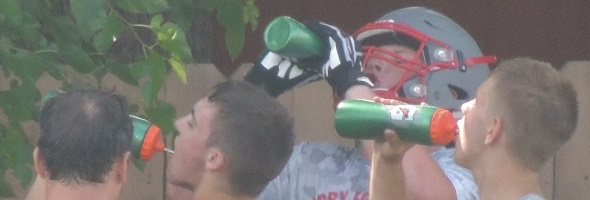
Participation Fee Numbers Hold Steady
June 27, 2012
Although the use of participation fees to help fund interscholastic athletics in Michigan high schools has doubled during the last nine years, the percentage of schools assessing them has held steady over the last two, according to surveys taken by the Michigan High School Athletic Association of its member institutions.
The most recently completed survey indicates that of 514 member schools participating, 260 schools – 50.5 percent – charged participation fees during the 2011-12 school year. In the 2010-11 survey, fees were being used at 50.4 percent of schools participating.
There were 763 senior high schools in the MHSAA membership this school year – the survey generated a response rate of 68 percent. This was the ninth survey of schools since the 2003-04, when members reported that fees were being used in 24 percent of schools.
The most recent survey also showed that fees incurred by students who paid once for an entire year of participation increased slightly from 2010-11 to 2011-12 – although the maximum fee per family decreased slightly.
The most popular method of assessing participation fees continues to be a payment for each sport an athlete goes out for, used by 41.5 percent of schools in 2011-12. That median fee among schools in the survey has increased only $5, to $75, since 2009-10.
A standardized annual fee per student was used by 24.5 percent of schools in the past year. Since Fall 2003, that fee has increased from $75 to $120 – a 60 percent increase – with the fee increasing $20 per athlete from 2010-11 to 2011-12.
Beginning with the 2004-05 survey, schools were asked in the survey if they had a cap on what individual student-athletes and families could be charged. Caps on student fees have been used by the majority of schools, but that number has dropped from 71.3 percent in 2004-05 to 55 percent in 2011-12. However, the number of schools instituting a cap on what a family pays has increased from 41 percent having a limit in 2004-05 to 49 percent in 2011-12.
Other data from the 2011-12 survey shows 64.5 percent of schools with participation fees have some kind of fee reduction or waiver program in place based on existing programs for subsidized lunch and milk (down from 68 percent in 2010-11); that 14 percent of schools using fees report a drop in participation; and that slightly more than one percent of schools report losing students to other school districts because they are charging fees. Five percent of schools not assessing fees in 2011-12 report transfers to their districts because of the absence of fees. Also, seven percent of schools not assessing fees had done so previously.
The survey for 2011-12 and surveys from previous years can be found on the MHSAA Website by clicking on Schools – Administrators – Pay-To-Play Resources.

Athletes: Get Ready to Beat the Heat
August 2, 2019
By Geoff Kimmerly
Second Half editor
While this summer may have seemed to arrive late in many parts of Michigan, the warm and sunny weather over these last few weeks has provided another reminder that student-athletes must prepare for training in hot weather that traditionally accompanies the beginning of August as MHSAA member schools prepare to begin fall sports practices this month.
Each year, the MHSAA provides information to its member schools to help them prepare for hot weather practice and game conditions during the late summer and early fall. Practices for cross country, football, Lower Peninsula girls golf, boys soccer and Lower Peninsula boys and Upper Peninsula girls tennis can begin August 12, with volleyball and Lower Peninsula girls swimming & diving able to start August. 14.
The “Health & Safety” page of the MHSAA Website has a number of links to various publications and information including guidelines for acclimatization from the National Athletic Trainers’ Association and recommendations on proper hydration from the National Federation of State High School Associations (NFHS). The preseason publication Heat Ways also is available for download and includes valuable information on heat management in addition to requirements and resources regarding head injuries and sudden cardiac arrest.
The first days of formal practices in hot weather should be more for heat acclimatization than the conditioning of athletes, and practices in such conditions need planning to become longer and more strenuous over a gradual progression of time. Schools also must consider moving practices to different locations or different times of day, or change practice plans to include different activities depending on the conditions. Furthermore, football practice rules allow for only helmets to be worn during the first two days, only shoulder pads to be added on the third and fourth days, and full pads to not be worn until the fifth day of team practice.
The MHSAA advises student-athletes to make sure to hydrate all day long – beginning before practice, continuing during and also after practice is done. Water and properly-formulated sports drinks are the best choices for hydration, while energy drinks, high-carbohydrate fruit juices (greater than eight percent carb content), carbonated and caffeinated beverages are among those that should be avoided.
A number of member schools follow the MHSAA’s Model Policy for Managing Heat & Humidity, which while not mandated for member schools was adopted as a rule for MHSAA postseason competition in 2013. The plan directs schools to begin monitoring the heat index at the activity site once the air temperature reaches 80 degrees, and provides recommendations when the heat index reaches certain points, including ceasing activities when it rises above 104 degrees. (When the temperature is below 80 degrees, there is no combination of heat and humidity that will result in a need to curtail activity.) The model heat & humidity policy is outlined in a number of places on the MHSAA Website, including as part of Heat Ways.

